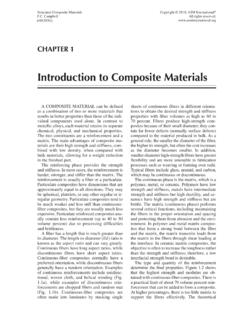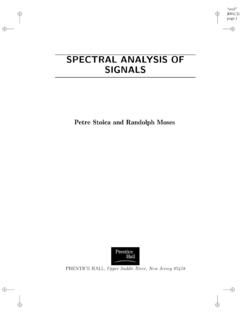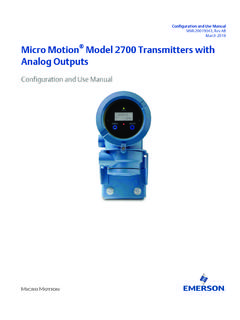Transcription of Geospatial Analysis 6th Edition, 2018 - de Smith ...
1 Geospatial Analysis A Comprehensive Guide to Principles Techniques and Software Tools 6th edition, 2018. Dr Michael J de Smith , Prof Michael F Goodchild Prof Paul A Longley & Associates Copyright 2007-2018 All Rights reserved. Sixth Edition. Issue version: 2018-2. No part of this publication may be reproduced, stored in a retrieval system or transmitted in any form or by any means, electronic, mechanical, photocopying, recording, scanning or otherwise, except under the terms of the UK Copyright Designs and Patents Act 1998 or with the written permission of the authors. The moral right of the authors has been asserted. Copies of this edition are available in print, electronic book and web-accessible formats. Users of mono print vesions should refer to the web or special PDF versions for color images. Disclaimer: This publication is designed to offer accurate and authoritative information in regard to the subject matter.
2 It is provided on the understanding that it is not supplied as a form of professional or advisory service. References to software products, datasets or publications are purely made for information purposes and the inclusion or exclusion of any such item does not imply recommendation or otherwise of the product or material in question. For more details please refer to the Guide's website: ISBN-13. 978-1-912556-03-8 Hardback 978-1-912556-04-5 Paperback 978-1-912556-05-2 ebook The cover image is OpenStreetMap contributors and shows the area around University College London with the public GPS trace data for the location date and time viewed. 3D visualization of modeled road-related noise levels in an urbanized area Visualization using CadnaA software, courtesy of Accon GmbH & DataKustik GmbH. Optimized service center location and allocated demand Tripolis, in Arcadia, Greece Coverage or p center location optimization problem.
3 See Section for more details. Map produced using S-Distance software (2006), courtesy of S A Sirigos Acknowledgements The authors would like to express their particular thanks to the following individuals and organizations: Accon GmbH, Greifenberg, Germany for permission to use the noise mapping images on the inside cover of this Guide and in Figure 3-4; Prof D Martin for permission to use Figure 4-19 and Figure 4-20; Prof D Dorling and colleagues for permission to use Figure 4-50 and Figure 4-52; Dr K. McGarigal for permission to use the Fragstats summary in Section ; Prof Wei Li and colleagues, China National Laboratory for High Speed Railway Construction for permission to use figures 4-69A and 4-69B; Dr H Kristinsson, Faculty of Engineering, University of Iceland for permission to use Figure 4-70;. Dr S Rana, formerly of the Center for Transport Studies, University College London for permission to use Figure 6-24; Prof B Jiang, Department of Technology and Built Environment of University of G vle, Sweden for permission to use the Axwoman software and sample data in Section and the inside cover page; Dr G Dubois, European Commission (EC), Joint Research Center Directorate (DG JRC) for comments on parts of Chapter 6 and permission to use material from the original AI-Geostats website.
4 Geovariances (France) for provision of an evaluation copy of their Isatis geostatistical software;. F O'Sullivan for use of Figure 6-41; Profs A Okabe, K Okunuki and S Shiode (Center for Spatial Information Science, Tokyo University, Japan) for use of their SANET software and sample data; and S. A Sirigos, University of Thesally, Greece for permission to use his Tripolis dataset, the provision of his S-Distance software, and comments on part of Chapter 7. Sections and of Chapter 8 are substantially derived from material researched and written by Christian Castle and Andrew Crooks (updated for the latest editions by Andrew) with the financial support of the Economic and Social Research Council (ESRC), Camden Primary Care Trust (PCT), and the Greater London Authority (GLA) Economics Unit. Chapter 9 has been substantially written by Guy Lansley of the UCL Consumer Data Research Centre.
5 We would also like to express our thanks to the many users of the book and website for their comments, suggestions and occasionally, corrections. Particular thanks for corrections go to Bryan Thrall, Juanita Francis-Begay, Paul Johnson and Prof Liem Tran. A number of the maps displayed in this Guide, notably those in Chapter 6, have been created using GB. Ordnance Survey data provided via the EDINA Digimap/JISC service. These datasets and other GB OS. data illustrated are Crown Copyright. Every effort has been made to acknowledge and establish copyright of materials used in this publication. The cover image is OpenStreetMap contributors and shows the area around University College London with the latest public GPS trace data for the location date and time viewed. Anyone with a query regarding any such item should contact the authors via the Guide's website, de Smith , Goodchild, Longley and Associates 7.
6 Table of Contents 1 Introduction and terminology 17. Spatial Analysis , GIS and software tools 20. Intended audience and scope 25. Software tools and Companion Materials 25. GIS and related software tools 26. Suggested reading 28. Terminology and Abbreviations 30. Definitions 30. Common Measures and Notation 38. Notation 38. Statistical measures and related formulas 40. 2 Conceptual Frameworks for Spatial Analysis 53. Basic Primitives 55. Place 55. Attributes 56. Objects 59. Maps 60. Multiple properties of places 61. Fields 62. Networks 63. density estimation 63. Detail, resolution, and scale 64. Topology 65. Spatial Relationships 66. Co-location 66. Distance, direction and spatial weights matrices 66. Multidimensional scaling 68. Spatial context 68. Neighborhood 69. Spatial heterogeneity 69. de Smith , Goodchild, Longley and Associates 8. Spatial dependence 70.
7 Spatial sampling 70. Spatial interpolation 71. Smoothing and sharpening 72. First- and second-order processes 72. Spatial Statistics 73. Spatial probability 73. Probability density 74. Uncertainty 74. Statistical inference 74. Spatial Data Infrastructure 76. Geoportals 76. Metadata 77. Interoperability 77. Conclusion 77. 3 Methodological Context 79. Analytical methodologies 81. Spatial Analysis as a process 85. Spatial Analysis and the PPDAC model 86. Problem: Framing the question 88. Plan: Formulating the approach 90. Data: Data acquisition 91. Analysis : Analytical methods and tools 93. Conclusions: Delivering the results 94. Geospatial Analysis and model building 95. The changing context of GIScience 100. 4 Building Blocks of Spatial Analysis 103. Spatial and Spatio-temporal Data Models and Methods 105. Geometric and Related Operations 110. Length and area for vector data 110.
8 Length and area for raster datasets 113. Surface area 114. de Smith , Goodchild, Longley and Associates 9. Line Smoothing and point-weeding 119. Centroids and centers 121. Point (object) in polygon (PIP) 128. Polygon decomposition 129. Shape 130. Overlay and combination operations 132. Areal interpolation 136. Districting and re-districting 138. Classification and clustering 143. Boundaries and zone membership 158. Tessellations and triangulations 167. Queries, Computations and density 172. Spatial selection and spatial queries 172. Simple calculations 173. Ratios, indices, normalization, standardization and rate smoothing 176. density , kernels and occupancy 180. Distance Operations 195. Metrics 197. Cost distance 202. Distance Transforms 209. Network distance 217. Buffering 218. Distance decay models 221. Directional Operations 225. Directional Analysis of linear datasets 226.
9 Directional Analysis of point datasets 231. Directional Analysis of surfaces 233. Grid Operations and Map Algebra 235. Operations on single and multiple grids 235. Linear spatial filtering 236. Non-linear spatial filtering 239. Erosion and dilation 240. 5 Data Exploration and Spatial Statistics 243. Statistical Methods and Spatial Data 245. de Smith , Goodchild, Longley and Associates 10. Descriptive statistics 248. Spatial sampling 248. Exploratory Spatial Data Analysis 255. EDA, ESDA and ESTDA 255. Outlier detection 258. Cross tabulations and conditional choropleth plots 261. ESDA and mapped point data 264. Trend Analysis of continuous data 265. Cluster hunting and scan statistics 265. Grid-based Statistics and Metrics 267. Overview of grid-based statistics 267. Crosstabulated grid data, the Kappa Index and Cramer's V statistic 268. Quadrat Analysis of grid datasets 271.
10 Landscape Metrics 273. Point Sets and Distance Statistics 279. Basic distance-derived statistics 280. Nearest neighbor methods 280. Pairwise distances 284. Hot spot and cluster Analysis 289. Proximity matrix comparisons 294. Spatial Autocorrelation 295. Autocorrelation, time series and spatial Analysis 295. Global spatial autocorrelation 298. Local indicators of spatial association (LISA) 312. Significance tests for autocorrelation indices 315. Spatial Regression 317. Regression overview 317. Simple regression and trend surface modeling 322. Geographically Weighted Regression (GWR) 325. Spatial autoregressive and Bayesian modeling 329. Spatial filtering models 337. 6 Surface and Field Analysis 339. Modeling Surfaces 341. Test datasets 341. de Smith , Goodchild, Longley and Associates 11. Surfaces and fields 342. Raster models 344. Vector models 347. Mathematical models 348.








